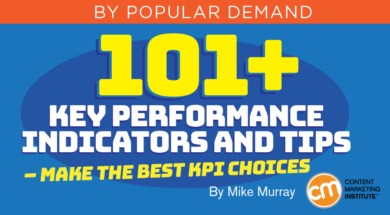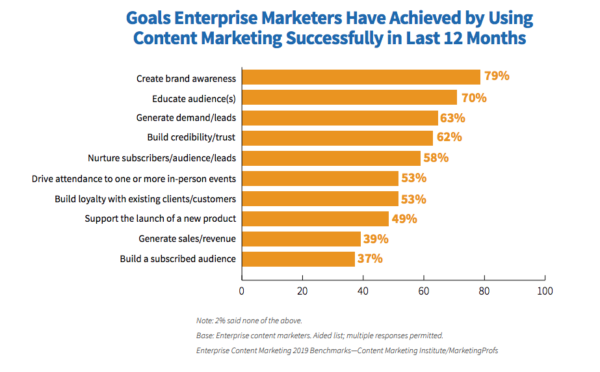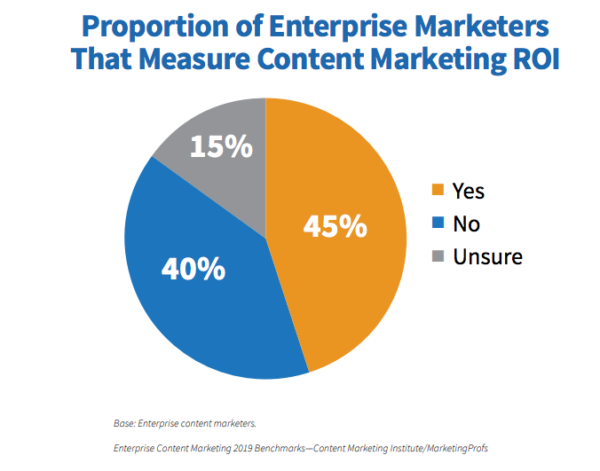 Editor’s note: You may have missed this article when CMI published it a few years ago. We’re sharing it now because choosing the right KPIs and measuring your content marketing activities are so important to the business.
Editor’s note: You may have missed this article when CMI published it a few years ago. We’re sharing it now because choosing the right KPIs and measuring your content marketing activities are so important to the business.
A long list of key performance indicators (KPIs) can be overwhelming, but don’t let that stop you from reading. You don’t need to use them all. You need to use them wisely.
You’ll likely see some you already use and discover some you never thought about. Reassess your current KPIs and see if you’re really measuring performance that matters to your content marketing and business goals. Maybe you’ll lock in on the ones that will complement what you have. Adapt any of these possibilities to suit your team’s needs.
Before jumping in, keep five KPI truths in mind:
1. KPIs are only as good as your content
All sorts of content marketing can trigger some KPIs – good or bad. The positive data depends on your content choices.
2. Tie each KPI to a goal
What are you trying to improve? What’s the end game? Could brand awareness use a boost? Are sales just so-so?
3. Don’t go too short
If you’re tracking only a few KPIs, you’re likely missing the mark. You might not get credit for what you’re accomplishing. Track the performance of your tactics and strategies.
4. Don’t go overboard
KPI overkill doesn’t make sense either. Think through who is responsible for analyzing what data. How much can be automated? Will someone see too much? What really tells the story?
5. KPIs can deceive and disappoint
Maybe your email open rate dropped. Bummer. How are you managing your lists? Maybe you’re not updating your data as often or in as many ways. A lower open rate might be related to the subject line. Maybe it’s just the time or day or year. Ultimately, how are people engaging with your content and taking additional actions? Maybe those numbers are better even with a lower open rate.
Identifying and measuring KPIs is essential for content marketers who are accountable for their decisions that range from one tweet to a series of well-researched white papers.
Enterprise marketers (working at companies and organizations with 1,000 employees) say content marketing has helped them achieve goals, such as generating demand/sales (63%), according to Enterprise Content Marketing 2019: Benchmarks, Budgets, and Trends North America.

Yet, the same study finds that marketers could do more to measure ROI – 55% of enterprise marketers don’t or aren’t sure whether they track it.

A key performance indicator is effective only if you’re actively measuring it. For example, if a campaign negatively affects ROI, the sooner you know the better.
Key performance indicators are only effective if you measure them, says @mikeonlinecoach. Click To TweetMarketers who measure their KPIs frequently can more easily identify bad campaigns and flip the switch before it affects the ultimate objective. Likewise, campaigns showing promise through positive key performance indicators can be further explored.
Pick KPIs that you are going to actively measure and stick to it.
Link marketing goals to the right KPI
If you only report KPI for show-and-tell, you’re doing a disservice to your business. KPIs mean little in the long run if they don’t match your goals. And you only know whether you’re chasing the right goals if you associate them with the right KPI.
Use multiple ROI metrics for the bigger picture
If you track only one KPI, you could negatively impact other metrics without realizing it. Analyzing several key performance indicators broadens and deepens your perspective on the strategy, tactic, or goal.
I like digital marketer Neil Patel’s cautionary note: “KPIs are all about quality – not quantity. They are about what really moves the needle for your business,” Patel writes in How to Use KPI Benchmarks to Drive Better Marketing Decisions (And Results).
Don’t neglect the KPI that keeps giving
Surprisingly, companies sometimes don’t do enough to factor in the customer lifetime value KPI.
Don’t neglect the #contentmarketing KPI that keeps giving – customer lifetime value, says @mikeonlinecoach. Click To TweetYou can decide what “lifetime” means to your business. It doesn’t need to be every purchase John Smith makes over the next 40 years. Even a few years of data can help you understand the value of a sale originated from paid search, SEO, or other content-focused initiatives.
Maybe a customer buys again because the product or service made a lasting impression. But some type of investment led to a KPI that helped the bottom line. Trace the impact like the average sale, average number of purchases over a defined period, and customer retention rate.
Pick from these KPIs
Hundreds of KPI categories can help marketers determine whether they’re meeting their goals or falling short. Here is a sampling of marketing, customer, and financial KPIs:
Marketing
- Cost per acquisition
- Market share
- Brand equity
- Cost per lead
- Conversion rate
- Click-through rate
- Page views
- Bounce rate
- Share of voice (SOV)
- Online share of voice (OSOV)
- Open rate
- Conversion rate
- Opt-out rate
- Subscribers
- Churn rate
- Click-through rate
- Delivery rate
SEO
- Sales
- Leads
- Conversion rate
- Visits
- Time on site
- Time on page
- Landing pages
- Keyword rankings
- Page views
- Bounce rate
- Indexed pages
- Increase in non-branded search traffic
- Increase in branded search traffic
- Referring websites (backlinks)
- Domain authority
- Page authority
Pay per click
- Cost per click
- Click-through rate
- Ad position
- Conversions
- Conversion rate
- Cost per conversion
- Cost per sale (CPS)
- Return on ad spend (ROAS)
- Wasted spend
- Impressions
- Quality score
- Total spend
Social media
- Amplification rate
- Applause rate
- Followers and fans (i.e., Facebook, Twitter, Pinterest)
- Conversion rate
- Landing page conversion rate
- Return on engagement (ROE)
- Post reach
E-commerce
- Annual sales
- Hourly, daily, weekly, monthly, quarterly sales
- Sales growth
- New customer vs. returning customer sales
- Conversion rate
- Website traffic
- Click-through rate
- Bounce rate
- Average order value
- Shopping cart abandonment rate
- Checkout abandonment rate
- Average margin
- Cost of goods sold
- Product affinity (different products purchased at the same time)
- Product relationship
- Inventory levels
- Competitive pricing
Miscellaneous
- Site traffic
- Texting subscribers
- Chat sessions
- Affiliate performance rates
- Product reviews
General website analytics
- Website traffic
- Unique visitors
- New vs. returning visitors
- Time on site
- Average time on page
- Bounce rate
- Exit rate
- Page views
- Page views per visit
- Traffic sources
- Geographic trends
- Mobile visitors
- Desktop visitors
- Visits per channel
Customers
- Net Promoter Score (NPS)
- Customer retention rate
- Customer lifetime value
- Customer turnover rate
Financial performance
- Gross profit
- Gross profit margin
- Net profit
- Net profit margin
- Operating profit margin
- EBITDA
- Return on assets (ROA)
- Working capital ratio
- Price earnings ratio (P/E ratio)
Learn more about KPIs and metrics
To dig deeper into KPIs and metrics, check out these resources:
- Digital Analytics Association
- Buffer’s 61 Key Social Media Metrics
- 31 Key Performance Indicators (KPIs) for Digital Marketing
- The E-Commerce Benchmark KPI Study: The Most Valuable Online Consumer Trend of 2018 Revealed [Video]
Make your selections
Everyone from a new social media specialist to the CEO of a Fortune 1000 company has a different perspective about which KPIs matters the most.
At the end of the day, it’s simply a matter of tracking what you’re trying to achieve. But remember, no matter what KPIs you pick, you must do one thing – don’t forget to actually measure them.
What KPIs work well for you?
Get assistance in boosting your key performance indicators. Subscribe to CMI’s free weekday newsletter with tips, trends, and insights into content marketing.
Cover image by Joseph Kalinowski/Content Marketing Institute

